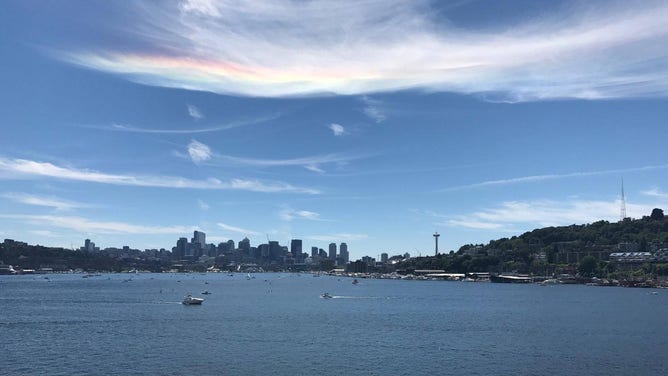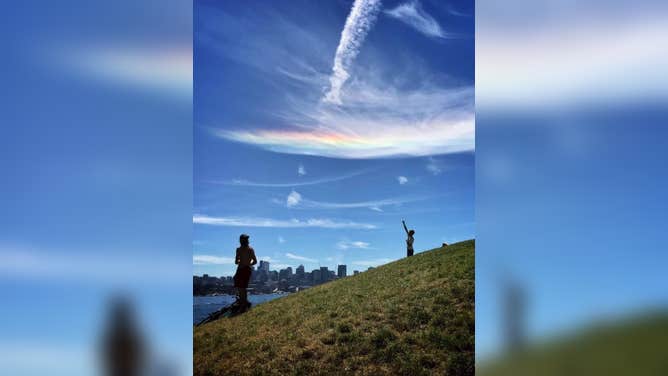How ice crystals can turn ordinary clouds into a brilliant display of rainbow colors
These rare "circumhorizonal arcs" light up clouds in the summertime into the colors of the rainbow, but can only happen when these certain conditions are met.

Circumhorizontal arc appears over Seattle on June 27, 2017.
The sun is shining on a summer day, and you head out at lunch. There's nary a raindrop around, yet as you take a glance to the sky, you spy these thin clouds below the sun lit up in the colors of the rainbow.
What you're seeing is a beautiful display of a "circumhorizontal arc."
And just like other rainbow-type displays in the sky, these arcs result from light refracting off some form of water droplets — though, in this case, they are tiny pieces of ice.
They're officially known as plate crystals. They have six sides like a hexagon with a flat top but also have a bit of thickness.
"So it's kind of like a dinner plate, and those actually tend slowly fall from the sky -- almost kind of fall straight down like a leaf," says scientist Michael Kavulich with the National Center for Atmospheric Research.

Circumhorizontal arc appears over Seattle on June 27, 2017
(Scott Mongrain)
Sunlight hitting the top and bottom of the flat parts of the crystals will reflect sunlight like a mirror, sometimes making a light pillar. Sunlight that sneaks through the sides of the crystals will refract the sunlight into a 22-degree halo.
WHAT MAKES A RAINBOW HALO AROUND THE SUN?
But there is one alignment where sunlight goes into the top of the crystal at an angle and comes out the side, and is refracted into the rainbow colors, similar to how a prism works. This somewhat tricky alignment will turn those thin, wispy clouds awash in color.

Circumhorizontal arc appears over Seattle on June 27, 2017
(Scott Mongrain)
Why so rare? To get that peculiar alignment, the sun has to be at least 58 degrees above the horizon, Kavulich says, with the brightest displays as it reaches as high as 68 degrees.
For the South, the sun reaching at least 58 degrees happens from roughly March through September, but it's a shorter window in the North. Spots like Seattle, Detroit, or Boston may only see the display for about a 6-week window on either side of the summer solstice.
"And of course, even though on these days when the sun barely gets to 58 degrees above the horizon, it does have to be right at (solar) noon to see that," Kavulich said. "So in places with northerly latitudes such as Seattle, it is a fairly rare display."
Is there an easier name for these ‘rainbow’ clouds?
"Circumhorizonal arc" is a bit of a mouthful for a name. Some years ago, the phenomenon attracted the moniker of "fire rainbow" after a sighting in Spokane as the clouds look like they are ‘afire with color,’ but many scientists frown at the name.
"I honestly can't blame people for calling it that because 'circumhorizontal arc' is kind of a mouthful," Kavulich said. "But (fire rainbow) is a misleading term that we don't like because it doesn't have anything to do with fire. And it's not related to rainbows."
They sometimes refer to it as "CHA"'s. Whatever you call it, it sure is a visual treat!